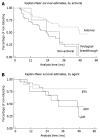Antiviral therapy delays esophageal variceal bleeding in hepatitis B virus-related cirrhosis
- PMID: 24187460
- PMCID: PMC3812484
- DOI: 10.3748/wjg.v19.i40.6849
Antiviral therapy delays esophageal variceal bleeding in hepatitis B virus-related cirrhosis
Abstract
Aim: To investigate the effect of antiviral therapy with nucleoside analogs in hepatitis B virus (HBV)-related cirrhosis and esophageal varices.
Methods: Eligible patients with HBV-related cirrhosis and esophageal varices who consulted two tertiary hospitals in Beijing, China, the Chinese Second Artillery General Hospital and Chinese PLA General Hospital, were enrolled in the study from January 2005 to December 2009. Of 117 patients, 79 received treatment with different nucleoside analogs and 38 served as controls. Bleeding rate, change in variceal grade and non-bleeding duration were analyzed. Multivariate Cox proportional hazard regression was used to identify factors related to esophageal variceal bleeding.
Results: The bleeding rate was decreased in the antiviral group compared to the control group (29.1% vs 65.8%, P < 0.001). Antiviral therapy was an independent factor related to esophageal bleeding in multivariate analysis (HR = 11.3, P < 0.001). The mean increase in variceal grade per year was lower in the antiviral group (1.0 ± 1.3 vs 1.7 ± 1.2, P = 0.003). Non-bleeding duration in the antiviral group was prolonged in the Kaplan-Meier model. Viral load rebound was observed in 3 cases in the lamivudine group and in 1 case in the adefovir group, all of whom experienced bleeding. Entecavir and adefovir resulted in lower bleeding rates (17.2% and 28.6%, respectively) than the control (P < 0.001 and P = 0.006, respectively), whereas lamivudine (53.3%) did not (P = 0.531).
Conclusion: Antiviral therapy delays the progression of esophageal varices and reduces bleeding risk in HBV-related cirrhosis, however, high-resistance agents tend to be ineffective for long-term treatment.
Keywords: Adefovir; Cirrhosis; Entecavir; Esophageal variceal bleeding; Hepatitis B virus; Lamivudine; Nucleoside analog; Resistance.
Figures


Similar articles
-
Antiviral therapy reduces rebleeding rate in patients with hepatitis B-related cirrhosis with acute variceal bleeding after endotherapy.BMC Gastroenterol. 2019 Jun 21;19(1):101. doi: 10.1186/s12876-019-1020-2. BMC Gastroenterol. 2019. PMID: 31226942 Free PMC article.
-
De novo combined lamivudine and adefovir dipivoxil therapy vs entecavir monotherapy for hepatitis B virus-related decompensated cirrhosis.World J Gastroenterol. 2013 Oct 7;19(37):6278-83. doi: 10.3748/wjg.v19.i37.6278. World J Gastroenterol. 2013. PMID: 24115827 Free PMC article. Clinical Trial.
-
Efficacy of combined therapy in patients with hepatitis B virus-related decompensated cirrhosis.World J Gastroenterol. 2013 Jun 14;19(22):3481-6. doi: 10.3748/wjg.v19.i22.3481. World J Gastroenterol. 2013. PMID: 23801842 Free PMC article. Clinical Trial.
-
Effects of entecavir and lamivudine for hepatitis B decompensated cirrhosis: meta-analysis.World J Gastroenterol. 2013 Oct 21;19(39):6665-78. doi: 10.3748/wjg.v19.i39.6665. World J Gastroenterol. 2013. PMID: 24151397 Free PMC article. Review.
-
Management of patients with decompensated HBV cirrhosis.Semin Liver Dis. 2003 Feb;23(1):89-100. doi: 10.1055/s-2003-37591. Semin Liver Dis. 2003. PMID: 12616454 Review.
Cited by
-
Systematic review and meta-analysis: impact of anti-viral therapy on portal hypertensive complications in HBV patients with advanced chronic liver disease.Hepatol Int. 2022 Oct;16(5):1052-1063. doi: 10.1007/s12072-022-10369-w. Epub 2022 Sep 9. Hepatol Int. 2022. PMID: 36083440
-
A novel prognostic model for predicting the risk of first variceal hemorrhage in patients with HBV-related cirrhosis.Front Cell Infect Microbiol. 2023 Jan 17;13:1062172. doi: 10.3389/fcimb.2023.1062172. eCollection 2023. Front Cell Infect Microbiol. 2023. PMID: 36733609 Free PMC article.
-
Antiviral therapy effectively improves liver hemodynamics as evidenced by serum biomarker and contrast-enhanced ultrasound examinations in patients with hepatitis B cirrhosis.PeerJ. 2018 Sep 12;6:e5484. doi: 10.7717/peerj.5484. eCollection 2018. PeerJ. 2018. PMID: 30225162 Free PMC article.
-
Antiviral therapy reduces rebleeding rate in patients with hepatitis B-related cirrhosis with acute variceal bleeding after endotherapy.BMC Gastroenterol. 2019 Jun 21;19(1):101. doi: 10.1186/s12876-019-1020-2. BMC Gastroenterol. 2019. PMID: 31226942 Free PMC article.
-
Variceal bleeding in cirrhotic patients.Gastroenterol Rep (Oxf). 2017 Aug;5(3):185-192. doi: 10.1093/gastro/gox024. Epub 2017 Jul 21. Gastroenterol Rep (Oxf). 2017. PMID: 28852523 Free PMC article. Review.
References
-
- Fattovich G, Giustina G, Schalm SW, Hadziyannis S, Sanchez-Tapias J, Almasio P, Christensen E, Krogsgaard K, Degos F, Carneiro de Moura M. Occurrence of hepatocellular carcinoma and decompensation in western European patients with cirrhosis type B. The EUROHEP Study Group on Hepatitis B Virus and Cirrhosis. Hepatology. 1995;21:77–82. - PubMed
-
- Realdi G, Fattovich G, Hadziyannis S, Schalm SW, Almasio P, Sanchez-Tapias J, Christensen E, Giustina G, Noventa F. Survival and prognostic factors in 366 patients with compensated cirrhosis type B: a multicenter study. The Investigators of the European Concerted Action on Viral Hepatitis (EUROHEP) J Hepatol. 1994;21:656–666. - PubMed
-
- Shah V, Long KH. Modeling our way toward the optimal management of variceal hemorrhage. Am J Gastroenterol. 2004;99:1289–1290. - PubMed
-
- Carbonell N, Pauwels A, Serfaty L, Fourdan O, Lévy VG, Poupon R. Improved survival after variceal bleeding in patients with cirrhosis over the past two decades. Hepatology. 2004;40:652–659. - PubMed
-
- Yao FY, Terrault NA, Freise C, Maslow L, Bass NM. Lamivudine treatment is beneficial in patients with severely decompensated cirrhosis and actively replicating hepatitis B infection awaiting liver transplantation: a comparative study using a matched, untreated cohort. Hepatology. 2001;34:411–416. - PubMed
Publication types
MeSH terms
Substances
LinkOut - more resources
Full Text Sources
Other Literature Sources
Medical

